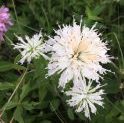When they are first learning about medicinal plants, a lot of people only recognize them when they look exactly the way they look when they are most commonly harvested.
While it usually makes sense to wait until the proper time to harvest a plant, sometimes emergency situations (such as an illness, and lack of access to other medicine) can mean that we have to harvest a plant during “off” times. So, I believe it’s important to come to recognize how a plant looks during all seasons when it’s growing, not just during its usual harvest time.
In the case of Waȟpé Waštémna, (aka Monarda fistulosa, Beebalm, Horsemint, Wild Bergamot, Elk Medicine, Wild Oregano, and many other names), people can often recognize it when its distinctive flowers, which range in color from white to magenta to red or purple, are out — but not when it’s young and first emerging in early summer.

This plant is in the mint family, which means that it has square stems, and leaves that grow in pairs, often forming a right angle with the previous pair of leaves, like a plus (+) sign. They are often slightly elongated, and usually have serrated edges.
Perhaps the easiest way to identify it at this stage, if you are not sure, is to gently rub the leaf and smell it. It has a very distinctive smell, and there are no other plants that smell alike that you’d find growing wild in Dakhóta Thamakhóčhe.
This is what waštémna (a common name for this plant in Dakota/Lakota country) looks like in June. This is about a month before the flowers come out, and therefore a month before the point when people usually harvest it. It’s just a couple inches tall at this point, but if you look closely in the tall prairie grass during this season, in the areas where this plant usually rows, you can often find these young plants getting started on their growing season.
